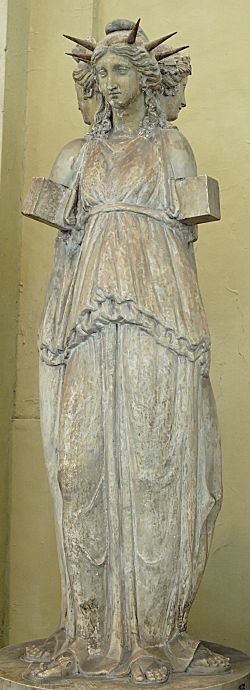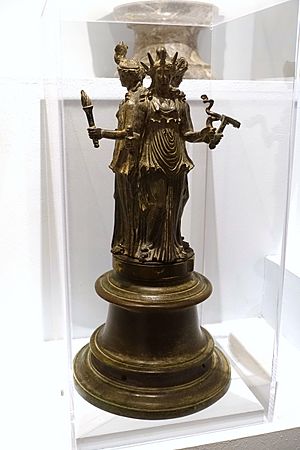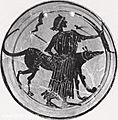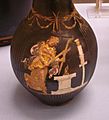Hecate facts for kids
Quick facts for kids Hecate |
|
|---|---|
| Goddess of boundaries, transitions, crossroads, magic, the New Moon, necromancy, and ghosts. | |

The Hecate Chiaramonti, a Roman sculpture of triple-bodied Hecate, after a Hellenistic original (Museo Chiaramonti, Vatican Museums)
|
|
| Abode | Underworld |
| Animals | Dog, polecat |
| Symbol | Paired torches, dogs, serpents, keys, daggers, and Hecate's wheel is known as a stropholos. |
| Offspring | Aegialeus, Circe, Empusa, Medea, Scylla |
| Parents | Perses and Asteria |
| Equivalents | |
| Mesopotamian equivalent | Ereshkigal (used as an epithet in a late Greek magical text) |
| Slavic equivalent | Marzanna |
Hecate (Greek: Ἑκάτη, Hekátē) is a powerful goddess in Greek mythology. She is known as the goddess of magic, crossroads, witchcraft, and ghosts. People in ancient Greece also saw her as a protector of homes.
Hecate was the daughter of Perses and Asteria. She was a Titan, but she chose to side with Zeus and his siblings during the great war called the Titanomachy. Because of her loyalty, Zeus honored her greatly. He allowed her to have power in the sky, on Earth, and in the Underworld. Hecate was often seen at night, living in underground caves or in the Underworld itself.
The ancient Romans knew Hecate by the name Trivia. This name means "three ways," which connects to her role as a protector of travelers and crossroads.
Contents
What Hecate Looked Like
Hecate was often shown with three forms or three bodies. This might have represented the past, present, and future. Her earliest images, however, showed her as a single figure.
Her main symbols were a pair of torches, keys, and daggers. The serpent, polecat, and dog were her special animals. In her three-headed statues, Hecate sometimes had animal heads like a cow, dog, boar, or horse.
Hecate's Special Plants
Hecate was closely linked to plants, especially those used for medicines and even poisons. People believed she liked offerings of garlic. She was also sometimes connected to the cypress tree, which was a symbol of death and the underworld.
Hecate's Powers and Roles
Hecate was often called upon to protect homes from evil spirits. She was also seen as a guardian of borders, like city walls, doorways, and crossroads. This meant she watched over places that were "between" different worlds, including the world of the living and the dead.
In the ancient city of Byzantium, Hecate was a protector. Legend says that when Philip of Macedon tried to attack the city, Hecate warned the people. She used her bright torches and her loyal pack of dogs to alert them.
Hecate is also known as a goddess of the underworld. She holds the keys that can unlock the gates of death. She guides not just roads, but all journeys, including the journey to the afterlife.
She helped the goddess Demeter search for her daughter Persephone. Persephone had been taken by Hades. Hecate guided Demeter's way at night with her flaming torches. After Persephone was found, Hecate often joined her as a companion on her yearly trips to and from the land of the dead.
Hecate was sometimes connected to the goddesses Artemis and Selene. She was also seen as a symbol of the harvest moon. By the 1st century CE, Hecate became strongly linked with witchcraft, witches, and magic.
Worship of Hecate
Hecate was a very popular goddess. People worshipped her all over Greece and Western Anatolia (modern-day Turkey). Caria was a major center for her worship. Her most famous temple was in the town of Lagina. Besides her own temples, Hecate was also worshipped in the sacred places of other gods.
People would place statues and altars of Hecate at three-way crossroads, and at the entrances to homes, temples, and cities. They believed this would protect them from restless spirits and other dangers.
Hecate's Family
In the oldest stories, Hecate was the only child of Perses and Asteria. Asteria was the sister of Leto, who was the mother of Artemis and Apollo. In some later stories, Hecate was given different parents.
Hecate never married and did not have a regular partner.
See also
 In Spanish: Hécate para niños
In Spanish: Hécate para niños
Images for kids
-
Hekataion with the Charites, Attic, 3rd century BCE (Glyptothek, Munich)
-
A goddess, probably Hecate (possibly Artemis), is depicted with a bow, dog and twin torches.
-
Hecate, Greek goddess of the crossroads; drawing by Stéphane Mallarmé in Les Dieux Antiques, nouvelle mythologie illustrée in Paris, 1880
-
The coins of Agathocles of Bactria (ruled 190–180 BCE), show Zeus holding Hecate in his hand.
-
Hecate battles Clytius next to Artemis, Gigantomachy frieze, Pergamon Altar, Pergamon Museum, Berlin.












